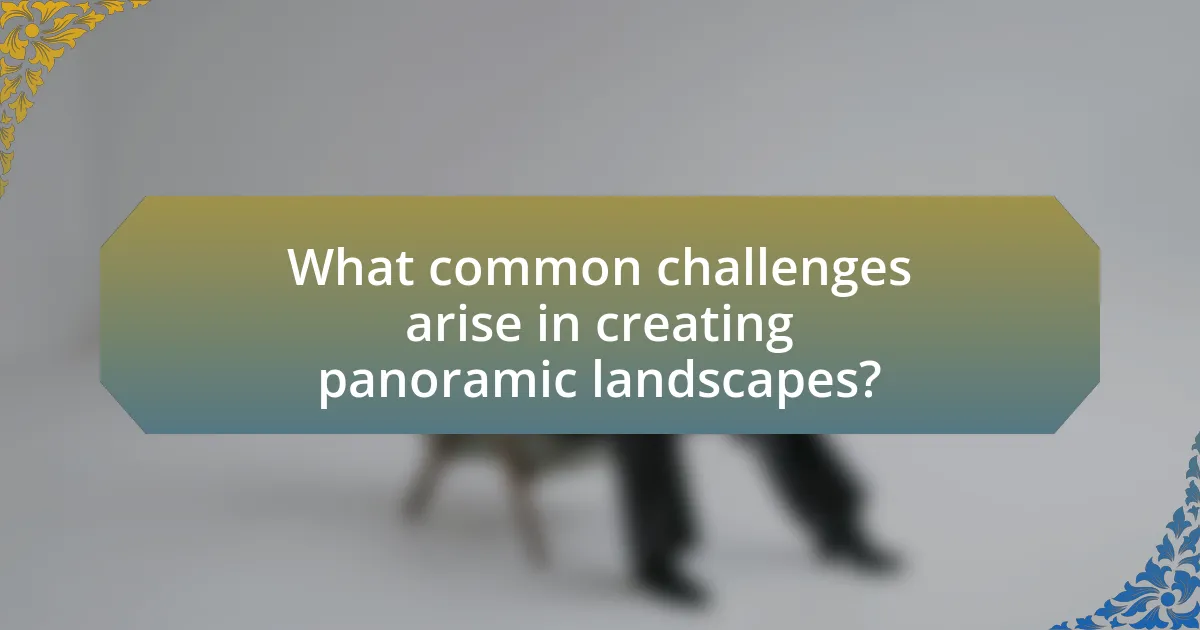Creating panoramic landscapes involves mastering key fundamentals such as composition, equipment selection, and stitching techniques. This article outlines the differences between panoramic and traditional landscapes, emphasizing the importance of perspective, depth, and lighting. Essential tools, including high-resolution cameras and tripods, are discussed, along with best practices for planning shoots and overcoming common challenges like exposure inconsistencies and stitching errors. Techniques for enhancing composition and utilizing leading lines are also covered, providing photographers with practical tips to improve their panoramic landscape photography skills.

What are the fundamentals of creating panoramic landscapes?
The fundamentals of creating panoramic landscapes include understanding composition, utilizing appropriate equipment, and mastering stitching techniques. Composition involves selecting a focal point and ensuring a balanced arrangement of elements across the wide frame. Equipment such as a tripod stabilizes the camera, while a wide-angle lens captures expansive views. Mastering stitching techniques is crucial, as it allows for the seamless merging of multiple images to create a cohesive panoramic photograph. Research indicates that effective panoramic photography often results from careful planning and execution, enhancing the overall visual impact of the landscape.
How do panoramic landscapes differ from traditional landscapes?
Panoramic landscapes differ from traditional landscapes primarily in their expansive field of view and composition. While traditional landscapes typically capture a limited perspective, often focusing on specific elements within a scene, panoramic landscapes encompass a wider angle, often exceeding 180 degrees, which allows for a more immersive experience. This broader perspective is achieved through specialized photography techniques or equipment, such as panoramic cameras or stitching multiple images together, resulting in a cohesive representation of a larger area. The ability to convey a sense of scale and context in panoramic landscapes enhances the viewer’s engagement with the scene, making it distinct from the more confined nature of traditional landscapes.
What elements define a panoramic landscape?
A panoramic landscape is defined by its wide field of view, typically encompassing a broad horizontal expanse that captures the essence of a scene. Key elements include depth, which creates a sense of three-dimensionality; composition, which organizes visual elements harmoniously; and lighting, which enhances colors and textures. Additionally, the inclusion of foreground, middle ground, and background elements contributes to the overall depth and perspective, allowing viewers to engage with the landscape more fully. These components work together to create an immersive experience, making panoramic landscapes visually striking and emotionally resonant.
Why is perspective important in panoramic landscapes?
Perspective is important in panoramic landscapes because it influences how viewers perceive depth and spatial relationships within the scene. By utilizing perspective, artists and photographers can create a sense of scale and dimension, making the landscape appear more immersive and realistic. For instance, the use of converging lines, such as roads or rivers, draws the viewer’s eye into the composition, enhancing the overall visual impact. Studies in visual perception indicate that effective perspective can significantly enhance the viewer’s emotional response and engagement with the landscape, making it a crucial element in the creation of panoramic imagery.
What tools and equipment are essential for creating panoramic landscapes?
Essential tools and equipment for creating panoramic landscapes include a high-resolution camera, a sturdy tripod, and a panoramic head. A high-resolution camera captures detailed images necessary for stitching multiple photos together, while a sturdy tripod ensures stability during the shooting process, preventing blurriness. A panoramic head allows for precise alignment of the camera, facilitating seamless stitching of images. These tools are critical for achieving high-quality panoramic landscapes, as they enhance image clarity and composition.
Which cameras are best suited for panoramic photography?
The best cameras suited for panoramic photography are those with high-resolution sensors and wide-angle capabilities, such as the Canon EOS R5 and the Sony A7R IV. These cameras offer excellent image quality and the ability to capture expansive scenes due to their large megapixel counts, which allow for detailed stitching of multiple images. For instance, the Canon EOS R5 features a 45-megapixel sensor, enabling high-resolution panoramic images, while the Sony A7R IV boasts a 61-megapixel sensor, providing even greater detail. Both cameras also support advanced autofocus systems and have robust lens options that enhance panoramic photography.
What accessories enhance the panoramic photography experience?
Tripods and panoramic heads are essential accessories that enhance the panoramic photography experience. A sturdy tripod provides stability, reducing camera shake during long exposures, while a panoramic head allows for precise alignment and rotation of the camera, ensuring seamless stitching of images. Additionally, using a remote shutter release minimizes vibrations caused by pressing the shutter button, further improving image quality. These accessories collectively contribute to capturing high-quality panoramic images by ensuring stability and accuracy in composition.
How can one effectively plan a panoramic landscape shoot?
To effectively plan a panoramic landscape shoot, one should first select a location that offers a wide and visually appealing view. Researching the area beforehand helps identify the best vantage points and compositions. Utilizing a tripod ensures stability for capturing multiple images that can be stitched together later. Additionally, considering the time of day for optimal lighting, such as during golden hour, enhances the overall quality of the images. Planning for weather conditions is also crucial, as clear skies or dramatic clouds can significantly impact the final result.
What factors should be considered when choosing a location?
When choosing a location for creating panoramic landscapes, factors such as accessibility, natural features, lighting conditions, and seasonal variations must be considered. Accessibility ensures that the site can be reached easily, which is crucial for transporting equipment and returning for multiple visits. Natural features, including mountains, bodies of water, and unique vegetation, contribute to the visual interest and composition of the landscape. Lighting conditions, particularly during golden hours (early morning and late afternoon), significantly affect the quality of the images captured. Seasonal variations can alter the landscape dramatically, providing different colors and textures throughout the year, which can enhance the overall aesthetic of the panoramic view.
How does time of day affect panoramic landscape photography?
Time of day significantly affects panoramic landscape photography by influencing lighting conditions, color temperature, and shadow length. During the golden hour, shortly after sunrise and before sunset, the soft, warm light enhances textures and colors, creating visually appealing images. Conversely, midday light can produce harsh shadows and overexposed highlights, which may detract from the overall quality of the photograph. Research indicates that the angle of sunlight changes throughout the day, impacting the mood and depth of the landscape, making early morning and late afternoon the most favorable times for capturing stunning panoramic shots.

What techniques can improve panoramic landscape photography?
To improve panoramic landscape photography, utilize techniques such as using a tripod for stability, employing a panoramic head for precise alignment, and capturing images in a series with overlapping frames. A tripod minimizes camera shake, ensuring sharp images, while a panoramic head allows for consistent rotation around the lens’s nodal point, preventing parallax errors. Capturing images with a 30% overlap between frames facilitates seamless stitching in post-processing, resulting in a cohesive final image. These methods are supported by the fact that professional photographers often emphasize the importance of stability and alignment in achieving high-quality panoramic images.
How can composition enhance panoramic landscapes?
Composition enhances panoramic landscapes by strategically arranging elements within the frame to create a sense of depth and balance. Effective composition techniques, such as the rule of thirds, lead lines, and framing, guide the viewer’s eye through the scene, making the landscape more engaging. For instance, placing a prominent foreground element can add depth, while using leading lines can draw attention to distant features, enhancing the overall visual impact. Studies in photography emphasize that well-composed images are more likely to evoke emotional responses, as they create a harmonious relationship between the various elements in the landscape.
What are the rules of composition to follow in panoramic photography?
The rules of composition to follow in panoramic photography include maintaining a strong foreground, using leading lines, ensuring balance, and considering the horizon line. A strong foreground anchors the image and provides context, while leading lines guide the viewer’s eye through the scene. Balance is crucial to avoid a lopsided appearance, and the horizon line should be placed thoughtfully to enhance the overall composition. These principles help create visually appealing panoramic images that effectively capture expansive landscapes.
How can leading lines be utilized in panoramic landscapes?
Leading lines can be utilized in panoramic landscapes by guiding the viewer’s eye through the composition, creating depth and perspective. Photographers can incorporate natural elements such as roads, rivers, or fences that stretch across the frame, effectively drawing attention to the horizon or focal points within the landscape. This technique enhances the visual flow and can evoke a sense of journey or exploration, making the panoramic image more engaging. Studies in visual perception indicate that leading lines significantly improve the viewer’s ability to navigate complex scenes, thereby increasing the overall impact of the photograph.
What are the best practices for stitching panoramic images?
The best practices for stitching panoramic images include ensuring consistent exposure settings, using a tripod for stability, and overlapping images by at least 30%. Consistent exposure settings prevent variations in brightness and color, which can disrupt the final image. A tripod stabilizes the camera, reducing motion blur and maintaining alignment between shots. Overlapping images by 30% allows stitching software to accurately identify common points, resulting in a seamless panorama. These practices are supported by photography guidelines that emphasize the importance of uniformity and precision in image capture for effective stitching.
How do you ensure alignment when stitching images together?
To ensure alignment when stitching images together, utilize overlapping regions between adjacent images to create a seamless transition. This technique relies on identifying common features in the overlapping areas, which can be achieved through software algorithms that detect key points and match them across images. For instance, using tools like Adobe Photoshop or specialized stitching software, the software analyzes the images and adjusts for perspective differences, ensuring that the final stitched image maintains a coherent look. Studies have shown that effective alignment can significantly enhance the quality of panoramic images, as proper feature matching reduces artifacts and improves overall visual continuity.
What software options are available for stitching panoramic photos?
Software options available for stitching panoramic photos include Adobe Photoshop, Hugin, PTGui, and Microsoft Image Composite Editor. Adobe Photoshop offers advanced features for photo editing and stitching, making it a popular choice among professionals. Hugin is an open-source alternative that provides powerful stitching capabilities and is widely used for its flexibility. PTGui is known for its speed and user-friendly interface, catering to both amateurs and professionals. Microsoft Image Composite Editor is a free tool that allows users to create panoramas easily, making it accessible for casual users. Each of these software options has unique features that cater to different user needs in panoramic photo stitching.
How can lighting and weather conditions impact panoramic landscapes?
Lighting and weather conditions significantly impact panoramic landscapes by altering visibility, color saturation, and mood. For instance, golden hour lighting, which occurs shortly after sunrise or before sunset, enhances colors and creates dramatic shadows, making landscapes appear more vibrant. Conversely, overcast weather can diffuse light, resulting in softer colors and a more subdued atmosphere. Additionally, weather phenomena such as fog or rain can add depth and texture to a scene, creating unique visual effects. Studies have shown that different lighting conditions can change the perception of a landscape, influencing how viewers emotionally respond to the scene.
What types of lighting are most effective for panoramic photography?
Natural lighting, particularly during the golden hour, is most effective for panoramic photography. This period, occurring shortly after sunrise and before sunset, provides soft, diffused light that enhances colors and reduces harsh shadows, making landscapes appear more vibrant. Additionally, overcast conditions can also be beneficial, as they create even lighting that minimizes contrast and allows for greater detail in the panoramic image. Studies in photography emphasize that the quality of light significantly impacts the overall aesthetic of landscape images, confirming that these lighting conditions yield the best results for panoramic compositions.
How do different weather conditions affect the final image?
Different weather conditions significantly affect the final image in panoramic landscapes by altering light quality, color saturation, and atmospheric clarity. For instance, overcast skies diffuse sunlight, resulting in softer shadows and more even lighting, which can enhance detail in the image. Conversely, bright sunlight can create harsh shadows and high contrast, potentially leading to loss of detail in highlights and shadows. Additionally, atmospheric conditions like fog or haze can add depth and mood to an image but may also reduce clarity and color vibrancy. Research indicates that the golden hour, shortly after sunrise or before sunset, provides optimal lighting conditions, enhancing color richness and texture in landscape photography.

What common challenges arise in creating panoramic landscapes?
Common challenges in creating panoramic landscapes include stitching errors, exposure inconsistencies, and perspective distortion. Stitching errors occur when images do not align properly, leading to visible seams in the final panorama. Exposure inconsistencies arise when different images have varying lighting conditions, resulting in an uneven appearance. Perspective distortion happens when the camera angle changes between shots, causing misalignment in the horizon or objects within the scene. These challenges can significantly impact the quality of the panoramic image, making careful planning and technique essential for successful results.
What are the typical pitfalls in panoramic photography?
The typical pitfalls in panoramic photography include misalignment of images, inconsistent exposure settings, and parallax errors. Misalignment occurs when images are not properly stitched together, leading to visible seams. Inconsistent exposure settings can result in varying brightness and color across the panorama, making it look unnatural. Parallax errors happen when objects at different distances shift between shots, causing distortion in the final image. These issues can significantly degrade the quality of panoramic photographs, making careful planning and execution essential for successful results.
How can one avoid distortion in panoramic images?
To avoid distortion in panoramic images, one should use a tripod and a panoramic head to ensure consistent alignment and rotation around the lens’s nodal point. This technique minimizes parallax errors that can lead to misalignment and distortion in the final image. Additionally, capturing images with overlapping fields of view, typically around 30%, helps in creating a seamless stitch during post-processing, further reducing distortion. Studies in photography emphasize that maintaining a consistent exposure and focus across all images also contributes to a more coherent final panorama, thereby enhancing overall image quality.
What strategies can mitigate issues with exposure and lighting?
To mitigate issues with exposure and lighting in panoramic landscapes, photographers can utilize techniques such as bracketing, using neutral density filters, and adjusting the shooting time. Bracketing involves taking multiple shots at different exposure levels to ensure that at least one image captures the correct lighting. Neutral density filters reduce the amount of light entering the lens, allowing for longer exposures without overexposing the image. Additionally, shooting during the golden hour, shortly after sunrise or before sunset, provides softer, more balanced lighting conditions, reducing harsh shadows and highlights. These strategies are effective in achieving well-exposed panoramic images.
How can one troubleshoot common problems in panoramic landscape photography?
To troubleshoot common problems in panoramic landscape photography, one should first identify issues such as misalignment, exposure inconsistencies, and distortion. Misalignment can be resolved by ensuring that the camera is mounted on a tripod with a level base, using a panoramic head if necessary. Exposure inconsistencies can be addressed by using manual settings for aperture, shutter speed, and ISO to maintain uniformity across all images. Distortion can be minimized by using a wide-angle lens with low distortion characteristics and correcting any remaining issues in post-processing software. These methods are supported by best practices in photography, which emphasize the importance of stability and consistent settings for achieving high-quality panoramic images.
What steps can be taken if images do not stitch correctly?
If images do not stitch correctly, the first step is to check the overlap between images; ideally, there should be at least 20-30% overlap for successful stitching. Insufficient overlap can lead to misalignment and stitching errors. Next, ensure that the images are taken from a consistent position and with the same camera settings, as variations in exposure or focal length can cause discrepancies. Additionally, using image editing software to manually align images can help correct minor stitching issues. Finally, if problems persist, consider using a different stitching algorithm or software, as some programs handle specific types of images better than others.
How can one address issues with focus and depth of field?
To address issues with focus and depth of field in panoramic landscapes, one should utilize a smaller aperture setting, such as f/8 to f/16, which increases the depth of field and ensures more elements in the scene are in focus. This technique is supported by the principle that a smaller aperture reduces the amount of light entering the lens, thereby enhancing the sharpness across various distances. Additionally, using a tripod stabilizes the camera, allowing for precise adjustments and consistent focus across multiple images, which is crucial for stitching together panoramic shots seamlessly.
What practical tips can enhance your panoramic landscape photography skills?
To enhance your panoramic landscape photography skills, utilize a tripod to ensure stability and consistency in your shots. A tripod minimizes camera shake, which is crucial for capturing sharp images, especially in low-light conditions or when using slow shutter speeds. Additionally, use a wide-angle lens to capture more of the scene, as these lenses allow for greater depth and breadth in panoramic compositions.
Employing the technique of overlapping images by 30-50% when stitching multiple photos together ensures a seamless final panorama. This overlap aids in the software’s ability to align and blend the images accurately, resulting in a cohesive photograph. Furthermore, shoot in manual mode to maintain consistent exposure settings across all images, preventing variations in brightness and color that can disrupt the final panorama.
Lastly, consider the composition by following the rule of thirds, placing key elements along the grid lines to create a more engaging image. This approach has been shown to enhance visual interest and balance in landscape photography.
How can practice and experimentation improve your technique?
Practice and experimentation enhance technique by allowing individuals to refine their skills through repetition and exploration. Engaging in consistent practice helps solidify foundational skills, while experimentation encourages creativity and adaptation to new methods. For instance, photographers who regularly practice capturing panoramic landscapes can develop a better understanding of composition, lighting, and camera settings, leading to improved results. Research indicates that deliberate practice, defined as focused and goal-oriented training, significantly contributes to skill acquisition and mastery (Ericsson, K. A., et al., 1993, “The Role of Deliberate Practice in the Acquisition of Expert Performance,” Psychological Review). Thus, both practice and experimentation are essential for advancing one’s technique in creating panoramic landscapes.
What resources are available for learning more about panoramic landscapes?
Books, online courses, and photography websites are valuable resources for learning about panoramic landscapes. Notable books include “Panorama: A History of the Panoramic Landscape” by David Green, which provides historical context and techniques. Online platforms like Coursera and Udemy offer courses specifically focused on panoramic photography, teaching skills from composition to editing. Additionally, websites such as PetaPixel and Digital Photography School feature articles and tutorials that cover tips and techniques for capturing and creating panoramic landscapes effectively.















